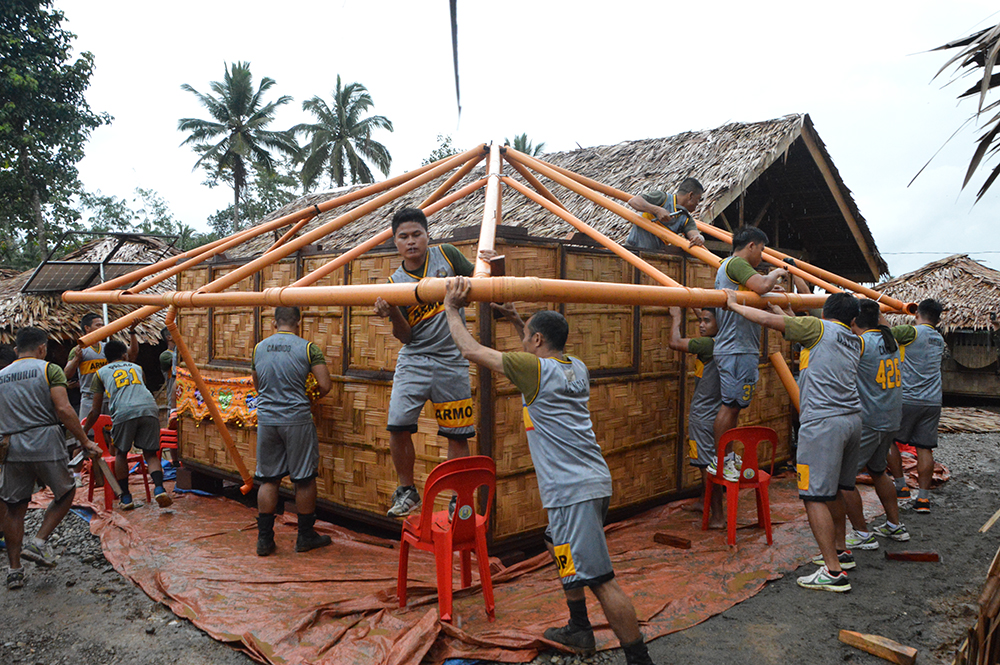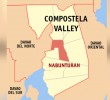
Government troops show their skills in a competition to build nipa huts in a temporary shelter area in Barangay Bito Buadi Itowa, Marawi City, during the visit of President Rody Duterte, Monday, October 2. Fifty houses were built in the area to be used as transition houses for the internally displaced families. (Divina M. Suson/davaotoday.com)
MARAWI CITY, Philippines – Some 50 families displaced in Marawi City received certificates of ownership of 8×8 meters “bahay kubo” (nipa huts) constructed inside a 1.2-hectare compound in Bito Buadi Itowa here Monday, October 2.
The huts are first batch of the Bahay Pag-asa (House of Hope) project, a joint effort of the government and the private sector, which aims to build transitional shelters for at least 1,500 families.
About 2,000 families wanted to avail of transitional shelters in the city, said Task Force Bangon Marawi Spokersperson Kristoffer James Purisima during the Mindanao Hour in Malacañang on Monday.
President Rodrigo Duterte, together with members of the Chinese-Filipino Business Club Inc. (CFBCI), attended the inauguration and turnover of the huts here on Monday, October 2.
Using the Tarlac Heritage Foundation’s model of the transitional houses, the CFBCI funded the construction and provided separate toilets and bathrooms for men and women, and a water tank that could save 5,000 liters and solar panels to provide electricity.
Samuel Uy, vice president of CFBBCI, said they are excited about the project because it is their first time to help the military and the Muslim community.
“Usually we help the fellow Christians, the poor Filipinos. But this time, more particularly, it’s the Muslim brothers and sisters. We are usually involved in so many activities—business, charitable, civic, educational, social. And when you talk about those things, we are assisting government, in a way, in helping people,” Uy said in an interview.
Some of the beneficiaries of the temporary shelters are soldiers and paramilitaries who are residents of Marawi, whose families were displaced by the war between the government forces and the ISIS-inspired militants that has been going on for more than four months now.
In his sixth visit in Marawi City, Duterte stepped inside for the first time in an evacuation center and one of the temporary shelters. But like in his previous visits, he did not spend time to interact with the displaced families who are staying in covered courts, gymnasiums and madrasahs as evacuation centers.
Vegetable garden
About 0.5 hectare land inside the compound is planted to vegetable and ornamental plants cultivated by the displaced families in the barangay.
Col Manny Garcia of the Joint Task Force Marawi said the garden, named as Hardin ng Lunas (Garden of Cure), is a component project conceptualized by the Tarlac Heritage Foundation.
They also planted several giant bamboo trees. As of October 2, their tomatoes are ready for harvest.
In the past months, some evacuees complained about their children getting sick and suffering from malnutrition, asking for cash assistance instead to buy vegetables instead of consuming only relief canned goods and instant noodles.
Based on the data provided by the Department of Social Welfare and Development 10 on its Facebook page, as of July, the total number of internally displaced persons (IDP) in the region was 45,958 families or 198,062 persons. The region has 35 evacuation centers housing 2,830 families or 13,267 persons, while there are 43,128 home-based displaced families or 184, 795 persons.(davaotoday.com)










